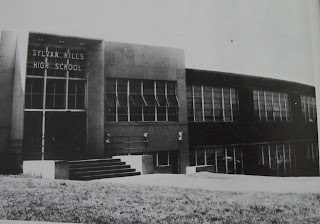By the early 1990s, construction of
homes on expansive lots of rolling hills and hardwood trees
encroached the land surrounding the Spout Spring Farm of my mother's
birth. Our family of twenty plus gathered in Lynchburg, Virginia, for my Aunt
Eleanor’s eightieth birthday in July of 1990. We drove the country
roads of Appomattox, some recently “black topped,” and took a walk, with
permission of the current, land owner, through their stomping grounds and
Poplar Tree Farm, where they had lived. Four of the remaining five sisters, Eleanor, Ava,
Harriett, and my mother, shared memories of a spot perhaps where something
had stood, pointed out the footprint of the house, both in and out, showed us the pole barn [still standing], or told the age worn stories of the spring behind the house and of the creek that my oldest brother Hunter crossed by himself when he was
barely four, the time when their Papa put up tobacco, or they stood nostalgically under the tree that held a swing where they had day-dreamed their
futures.
The four sisters didn't shed tears, but
they drifted occasionally to these long away looks about a past time.
My father took several long trips to
Fulton, Missouri, in search of information for his memoir, A
McDaniel Remembers, which he completed in 1994, one year
before his death. He dedicated his memories to his grandchildren in
“the hope that this book will give them a glimpse of the life and
world in which their grandfather lived on a farm in Central Missouri
in the early part of the twentieth century.” Daddy always talked
fondly about his family, the horse he rode to school, and the dusty,
country roads he drove in Callaway County, the seat of his birth and
growing up years. A sentimental man, my daddy could get teary eyed
and seem to go somewhere else as he recalled his past.
Daddy on a road in Missouri, circa early 1980s
As children we didn't travel to daddy's
home land – his parents dead, and his cousins scattered into places
like Texas and Arkansas. We went to Virginia where my mother had
“living” kin.
We always knew more of Virginia than
Missouri --- and there are many underlying reasons perhaps for this –
other than kin – or maybe because of kin. My maternal family made
up of sisters, who when they were together told stories and laughed –
my dad – an only child – didn't have those connections.
---------------------------------------------------------------------------------------------------------
If you read my blogs, you know I have that longing --- not for it especially – but of it --- my childhood, the neighborhood, my parents, the shared memories, and the love that they surrounded me with as I grew up.
---------------------------------------------------------------------------------------------------------
If you read my blogs, you know I have that longing --- not for it especially – but of it --- my childhood, the neighborhood, my parents, the shared memories, and the love that they surrounded me with as I grew up.
I now live on the northern side of
Atlanta, my childhood roving fields thirty miles to the south, so
those areas where I rode my bike and later rode around have not been
traversed by me much since 1978 when my parents moved to Roswell. There
they lived for another eighteen years until their deaths in 1995.
My siblings and I went to college, got
jobs, later married, and set ourselves up in the northern environs of
the metropolitan Atlanta area. My older brother set up roots even
farther away in Virginia and then later Colorado.
In the last forty years, I may have
exited the Interstate at Lakewood Freeway or State Road 166 [renamed Langford Parkway] to ride through my old
haunts a total of five or six times. At each visit, the places
appeared smaller, more dilapidated, and surreal – street names
changed, businesses altered or torn down. Did I really grow up here?
Is this the same place?
My elementary school, Perkerson, Atlanta Public Schools demolished a decade or more ago: the original building where I attended
school, built in the 1920s, made way for a newer, more modern building --- not
a smidgen of its old image left as the new building sprawled across the
playground and ate up its space. The products of that old school lost bragging rights to those lesser elementary schools in that area [Capitol View and Sylvan Hills] when that happened cause we had proudly boasted about the square footage of our "grounds" -- big enough to run a football, baseball, and soccer game simultaneously.
In the last two weeks, through the power of Facebook and email, the news came to me of the end of two more physical reminders of that life I had in south Atlanta.
Now set for demolition is my high school, Sylvan Hills High School, built in 1949, to make way for a new middle school.
In the last two weeks, through the power of Facebook and email, the news came to me of the end of two more physical reminders of that life I had in south Atlanta.
*makes sad face*
Now set for demolition is my high school, Sylvan Hills High School, built in 1949, to make way for a new middle school.
from the Golden Memories, Sylvan's yearbook, 1967
from the Golden Memories, 1967
And, the church of my youth, Mary
Branan Methodist, will close its doors tomorrow with a “final
benediction of … hymns, prayers, and covered dishe[s].”
from an ad in the Golden Memories, 1967
from an ad in the Golden Memories, 1967
Mary Branan United Methodist Church, Sylvan Hills
part of my church, youth group in Savannah, 1969 -- Diane, Linda, Gloria, Robin, Cheryl, and I (thanks to Linda for that snapshot)
So, good bye to those two places of
---
bonfires, a stained glass window of Jesus at Gethsemane, pass or fail, hand held fans, pep rallies, Vacation Bible School, Atlanta Dairy's small carton of milk, Annie Maude's sandwiches, homeroom with Mrs. Powell, Easter dresses, Civics with Mr. Elder, revival meetings and “Blessed Assurance,” casement windows, living in the steeple stories, the Ramp, choir practice, drill team, “ please can I sit in the balcony for church service?,” the Golden Bear donated by the class of 1966 in the foyer, coffee and doughnuts between Sunday school and church, the clinic with Mrs. Savage, The Good News, the principal's office with its long counter full of forms, baskets, and other detritus, Christmas pageants with angels on the roof, suits and ties, saddle-oxfords, bulletins, detention, MYF, the quarter system, playing Dots and Boxes on the backs of offering envelopes with those stubby, dull pencils, early morning waiting in the gym for school to start, church solos, football games at Cheney and Grady stadiums, youth trips to Wesley Gardens, learning to type, memorizing Bible verses, Algebra with Reverend Rogers, pot luck suppers, sub-freshmen,....
bonfires, a stained glass window of Jesus at Gethsemane, pass or fail, hand held fans, pep rallies, Vacation Bible School, Atlanta Dairy's small carton of milk, Annie Maude's sandwiches, homeroom with Mrs. Powell, Easter dresses, Civics with Mr. Elder, revival meetings and “Blessed Assurance,” casement windows, living in the steeple stories, the Ramp, choir practice, drill team, “ please can I sit in the balcony for church service?,” the Golden Bear donated by the class of 1966 in the foyer, coffee and doughnuts between Sunday school and church, the clinic with Mrs. Savage, The Good News, the principal's office with its long counter full of forms, baskets, and other detritus, Christmas pageants with angels on the roof, suits and ties, saddle-oxfords, bulletins, detention, MYF, the quarter system, playing Dots and Boxes on the backs of offering envelopes with those stubby, dull pencils, early morning waiting in the gym for school to start, church solos, football games at Cheney and Grady stadiums, youth trips to Wesley Gardens, learning to type, memorizing Bible verses, Algebra with Reverend Rogers, pot luck suppers, sub-freshmen,....
Kenneth, Golden Memories, 1971
Harriett, 1971, Golden Memories
When I reminisced with my brother Kenneth about the endings of these two settings of our youth, he set me up: “Looks like you got a lot of stories to tell for your blog.”
Sigh.
I think I do.
Note: When I heard Sylvan was being demolished, I did an Internet search to try and find some background on it. This is what I found ---
Note: When I heard Sylvan was being demolished, I did an Internet search to try and find some background on it. This is what I found ---








































